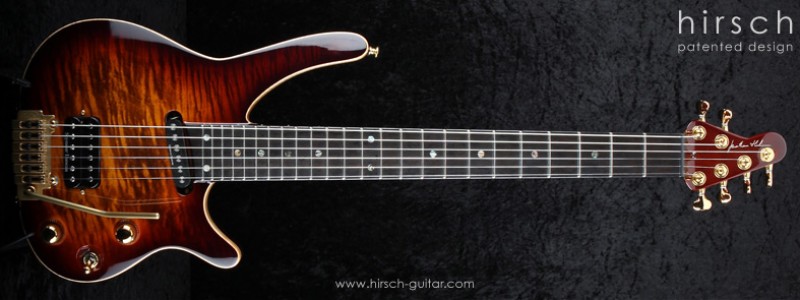I went over to Simon’s workshop the other day to collect guitar number two. This is a pre-production prototype I commissioned from him as a way of testing out our envisaged production process using CNC – although the guitars will be essentially hand-built, the actual wood carving will be computer-controlled to ensure consistency from one guitar to the next. As an individual guitar, I’m very pleased with the result – #2 plays and sounds fantastic and I love the metallic silver finish – but as a template for future production models, there are a few issues.

Hirsch SB-1 Prototype #2 in custom Calton hardshell case
The main one is that it seems the scanning process wasn’t as accurate as it needed to be, which resulted in the computer struggling to re-create the deeply carved top of the original. Consequently Simon had to do a fair bit of remedial woodwork – fine for a one-off, but not really viable for a multi-unit production run.
Secondly, while the original prototype used a through-neck approach, this one uses a set-neck, with the body and neck machined separately and then glued together. At first, I had some reservations about this as I felt a through-neck would make for a better guitar. However, machining the neck and body as a single piece will not be practical in production, especially as I want to be able to include a maple cap on some guitars. For one thing, too much wood would be wasted; for another, the production logistics become hugely more complicated. As it turns out, #2 actually has much more sustain, and to my ears a beefier sound, than the original, which probably goes to show that the choice of wood has far more to do with sound than the construction approach. However, on this particular guitar, some remedial work was again required to correctly set the neck – not a problem for now, the result is still fantastic, but not scalable for production.
This guitar is also pretty heavy, quite a bit heavier than the original prototype – this is basically down to the choice of wood (sapele, whereas the original was mahogany), so could be fixed by using a lighter choice, but it has got me thinking of other options for reducing weight.

Hirsch SB-1 Prototypes #1 & #2 (and early-60's Vox AC30)
So, after discussions with Simon and Martin – who’s handling the CNC side of things for me – and after weighing up a number of options, I’ve decided the best solution is to simplify the surface contouring to a shape that is more easily replicable by the CNC system. I’m going to go with a fairly simple top-to-bottom surface radius, which we’ll also replicate on the back of the guitar. This should make the guitar that little bit more comfortable to play, and lighter, as well as simplifying the production process – although this does introduce a few other issues that we’ll need to work around, but all do-able I think.
This modified surface contouring also – finally! – gives me a name for the guitar: the Hirsch SB-1 Radius, or maybe just Hirsch Radius for short.
Funnily enough, I dug out my original drawings and notes the other day and unearthed an old paper-maché mock-up of the body that I made way back in 1992 or so, and that actually had more or less the same front-and-back surface contouring – so it seems I’m actually just returning to what I’d originally envisaged but inadvertently moved away from over the years. Full circle!
